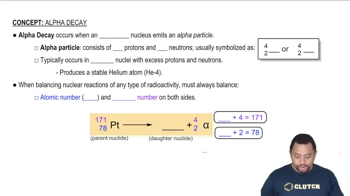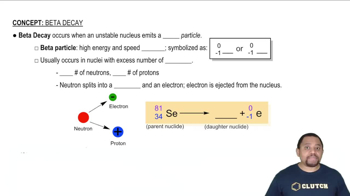Here are the essential concepts you must grasp in order to answer the question correctly.
Nuclear Decay
Nuclear decay is a process by which an unstable atomic nucleus loses energy by emitting radiation. This can occur in various forms, including alpha decay, beta decay, and gamma decay. Understanding the type of decay is crucial for predicting the particles produced and the resulting elements formed.
Recommended video:
Beta Decay
Beta decay is a specific type of radioactive decay in which a neutron in the nucleus is transformed into a proton, emitting an electron (beta particle) and an antineutrino. This process increases the atomic number of the element by one, resulting in the formation of a new element. In the case of iodine-122, it undergoes beta decay to become xenon-122.
Recommended video:
Conservation of Mass and Charge
In nuclear reactions, the conservation of mass and charge is a fundamental principle stating that the total mass and charge before and after the decay must remain constant. This means that the sum of the atomic numbers and mass numbers of the reactants must equal those of the products, allowing us to identify the particles produced during decay processes.
Recommended video:
Law of Conservation of Mass

 Verified step by step guidance
Verified step by step guidance


